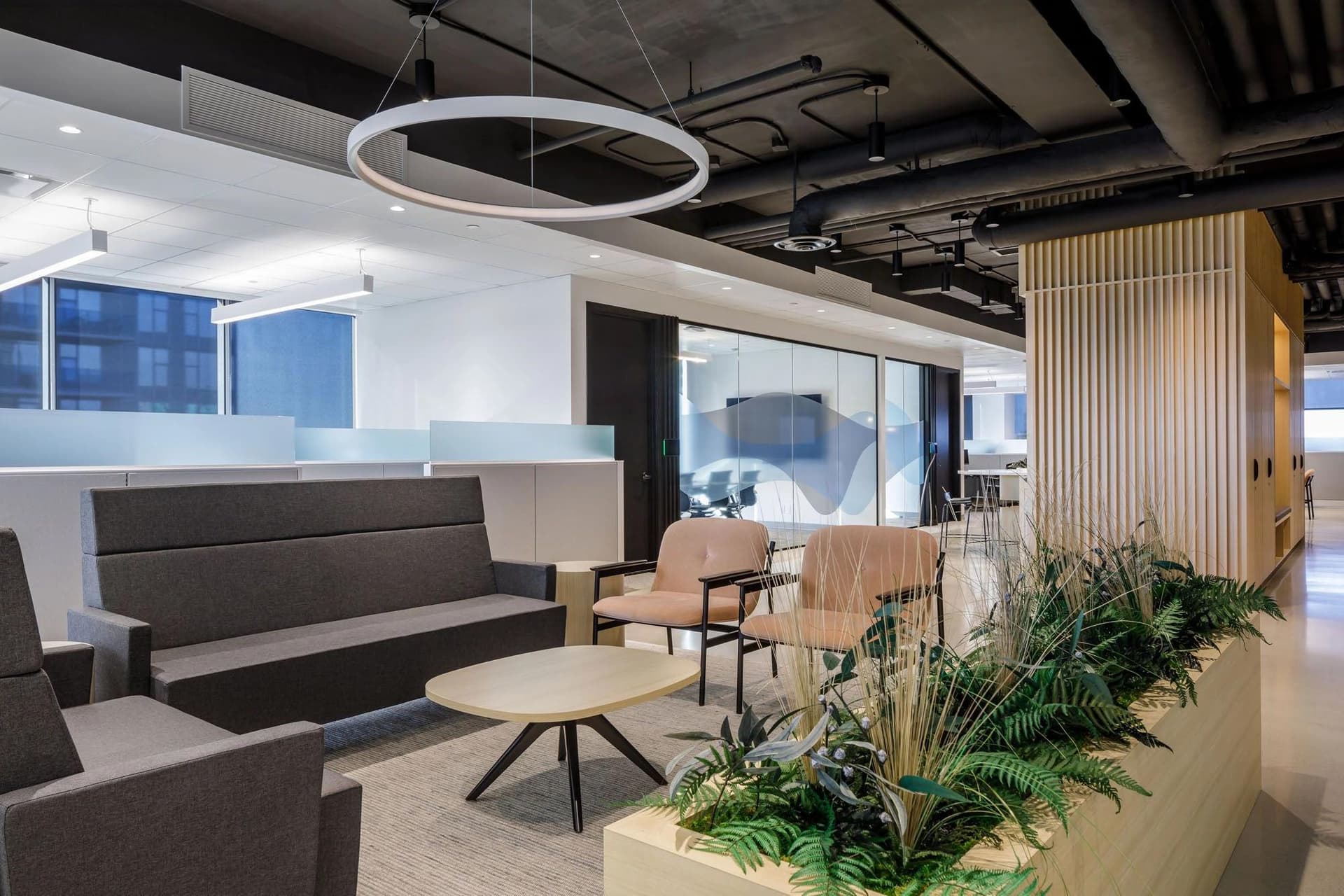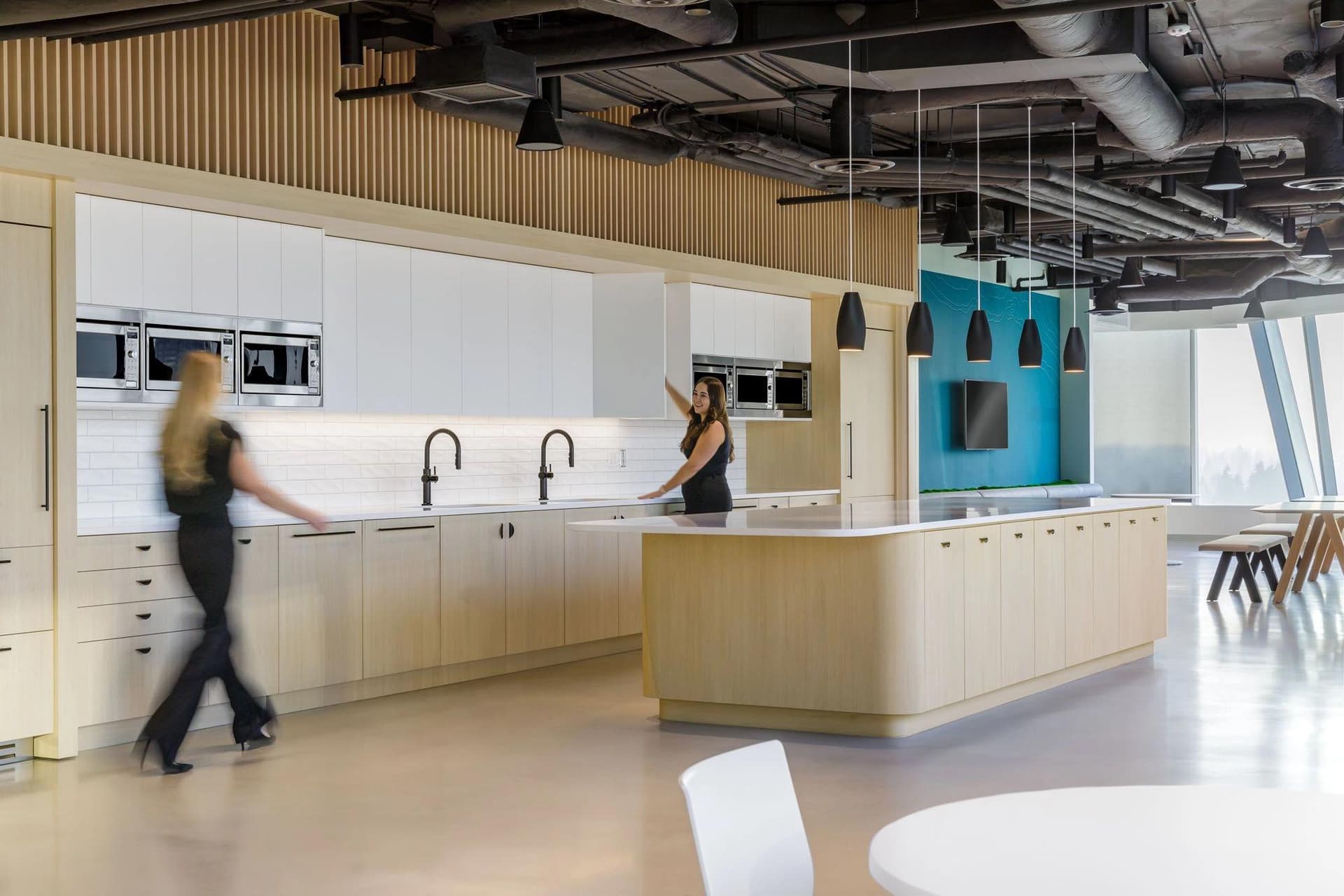Crafting Dynamic Workspaces for Large Corporations: Challenges and Solutions
Discover the unique challenges and opportunities large corporations face when designing and building their workspaces.
High-performing workplaces are essential for fostering productivity, innovation, and employee satisfaction. Designing such spaces requires a focus on supporting people and connection, integrating intuitive technology, and reflecting the company’s brand and culture. When it comes to creating expansive workspaces for larger corporations—those requiring over 40,000 square feet—these principles become even more crucial. Such large-scale projects present unique challenges and opportunities that demand a sophisticated approach. This article will explore these challenges and opportunities, showcasing Aura’s expertise in seamlessly navigating and executing large-scale design-build projects that enhance connectivity, flexibility, and corporate identity for large corporations.
Innovative Workspaces for Large Corporations: Challenges and Opportunities
Designing for expansive teams presents unique challenges and opportunities that go beyond mere scale. It requires creating environments that not only accommodate large numbers of employees but also promote collaboration, innovation, and a strong sense of brand identity. The challenge lies in balancing the need for individual workspaces with collaborative areas, ensuring seamless communication across diverse departments, and integrating technology that supports these interactions. The opportunity, however, is in crafting spaces that inspire creativity and reflect the corporation’s values and culture, thereby enhancing employee engagement and productivity while reinforcing the brand’s ethos and image.
Challenge: Diminished Collaboration, Connection, and Culture
Designing workplaces with multiple floors presents distinct challenges in maintaining company culture and fostering staff collaboration and connection. The physical separation of employees across different floors can lead to a fragmented company culture, where communication and collaboration are hindered. This division can create isolated workgroups, reducing the likelihood of spontaneous interactions and shared experiences that are crucial for a cohesive work environment. In hybrid office models, the disparity between remote and on-site employees can result in unevenly populated floors, with some areas feeling deserted while others are overly busy. This uneven distribution of staff further complicates efforts to maintain a unified and engaging workplace, making it difficult to nurture a strong organizational culture.
“We are four times as likely to communicate regularly with someone sitting six feet away from us as with someone 60 feet away, and we almost never communicate with colleagues on separate floors or in separate buildings.”
Solution: Vertical Integrations, Communal Areas, and Desk Booking
To overcome these challenges, companies can implement several design strategies and solutions. Firstly, companies can enhance vertical circulation by integrating an interconnecting staircase to encourage movement and interaction between floors. Secondly, incorporating shared and common spaces on each floor can mitigate the isolation effect by providing venues for informal gatherings and collaboration, thus promoting spontaneous interactions. Furthermore, optimizing the lunchroom by placing it in a prime location within the workplace can encourage employees to gather there during lunchtime. Equipping the lunchroom with amenities not available in common areas on each floor can further motivate staff to visit this central location, fostering interaction with colleagues from different departments and floors.
Advanced scheduling systems, such as desk-booking applications, can help balance occupancy levels by allowing employees to see who will be in the office on any given day. This enables staff to make informed decisions about when to come into the office and which floor to book, promoting a more even distribution of occupancy and facilitating better collaboration for large corporations.
Challenge: Foresight and Adaptability
Designing for large teams requires a blend of foresight, adaptability, and a deep understanding of corporate dynamics. Planning for the long term is particularly difficult because large companies are susceptible to business changes such as market shifts, mergers, or layoffs. Ensuring that the workspace can adapt to these changes requires a flexible layout and infrastructure, which involves investments in modular furniture, moveable walls, and advanced technological systems. By prioritizing adaptability and flexibility in the design phase, companies can create workspaces that can seamlessly evolve with their changing requirements, enhancing productivity and employee satisfaction in the long run.
Solution: Modular Planning for Flexibility
Investing in specific solutions to address the challenges of adaptability and flexibility in large workplace design is crucial for companies aiming to future-proof their environments. A robust workplace strategy, grounded in data-driven decision-making, can provide invaluable insights into how best to optimize the workspace for evolving needs. By conducting thorough research and forecasting, businesses can anticipate potential shifts in industry trends, technology advancements, and workforce dynamics, enabling them to proactively design spaces that are adaptable to change.
Incorporating modular planning into workplace design allows for the accommodation of company growth and structural changes. This might involve incorporating modular furniture that can be easily reconfigured to accommodate different team sizes or workflow changes. Moveable walls and partitions can provide flexibility in creating separate areas for collaboration or privacy as needed. Multi-purpose spaces and movable partitions can help create an environment that is easily reconfigurable as needed. By embracing these solutions, companies can create workspaces that not only meet current needs but also remain agile and responsive to future challenges and opportunities.
Case Study: Westland Insurance
Westland Insurance’s new headquarters, spanning 60,000 square feet over five floors in the King George Hub in Surrey, BC, exemplifies effective office design for large corporations. To enhance navigability, social and support spaces are consistently located on each floor, providing familiarity and ease of movement within the workspaces.
Each floor features a small kitchenette and coffee area for immediate needs, while the top floor boasts a larger staff kitchen and lounge equipped with unique appliances. This intentional design draws employees to the top floor during breaks, promoting cross-departmental interactions and fostering a sense of community. The result is a cohesive and engaging work environment tailored to the needs of a large corporation.
What This Means for Large Organizations
Designing offices for large corporations requires a strategic approach that balances functionality, flexibility, and the promotion of a cohesive company culture. By understanding the unique challenges of multi-floor offices, incorporating modular planning, and fostering connectivity and collaboration, we create workspaces that not only meet the immediate needs of large teams but also support their growth and evolution. Our expertise in integrated design-build ensures that each project reflects the distinctive culture and operational requirements of our clients, crafting the best workspaces for their success.






